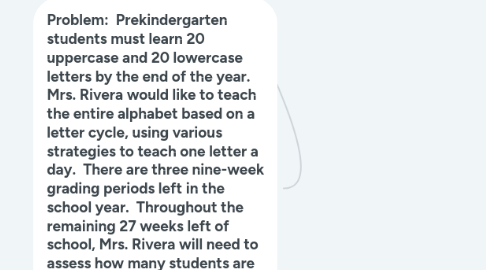letter cycle
by Margarita Rivera

1. Problem: Prekindergarten students must learn 20 uppercase and 20 lowercase letters by the end of the year. Mrs. Rivera would like to teach the entire alphabet based on a letter cycle, using various strategies to teach one letter a day. There are three nine-week grading periods left in the school year. Throughout the remaining 27 weeks left of school, Mrs. Rivera will need to assess how many students are learning the letters that are taught daily. She will need to figure out when to informally assess while continuing to follow the letter cycle.
2. Decomposition: First Mrs. Rivera will need to decide which order she would like to teach the alphabet and if she will teach each uppercase and lowercase letters at the same time. A list of different teaching strategies will need to be determined. She will then need to come up with a method to assess and track growth and mastery of letters. Finally, she will need to determine a timeline on how the letter cycle and assessments will be planned in each nine-week grading period.
3. Algorithm design: For the three nine-week grading periods Mrs. Rivera will use the first eight weeks to teach one letter a day and will assess on the ninth week. This will give 40 days of instruction and five days for assessment. Mrs. Rivera will be able to teach all 26 letters in the alphabet at least once and then start a new cycle of the alphabet on the 27th day of instruction. The alphabet will be taught in alphabetic order. During the week of assessment, Mrs. Rivera will collect data and determine which letters have been mastered. The graph used to collect data will display which letters need to be reviewed more frequently.
4. References: Yadav, A., Hong, H. & Stephenson, C. (2016). Computational thinking for all: Pedagogical approaches to embedding 21st century problem solving in K-12 classrooms. TechTrends, 60(6), 565-568. Wolfram, S. (2016, September 7). How to teach computational thinking. Wired. Retrived from How to Teach Computational Thinking
5. Pattern recognition: Mrs. Rivera will look up different methods on how to teach letter and sound recognition and determine which method best suits her student’s needs. The students are familiar with the singing the alphabet song and exposed to the letters (both uppercase and lowercase letters) displayed on the word wall. One method is teaching the letters in alphabetic order and teaching both uppercase and lowercase letters at the same time. A list of strategies is determined with the help of her team. ABC books, handwriting without tears, circle maps, and letter tubs are all strategies that will be used. Mrs. Rivera will use a spreadsheet to keep track of each student’s progress. As Mrs. Rivera plans lessons and assessments, she realizes that the last week of the nine-week grading period will need to be used for assessment. The last week of the grading period will not be on a letter cycle. This will leave 24 full weeks that will follow the letter a day letter cycle.
6. Rationale: While decomposing my problem I first determined which factors contribute to my problem. I also thought about what specific parts needed a solution. I felt that it was important to address every aspect of the problem because, even though I am familiar with this topic, I wanted to be able to explain it to someone who is not so familiar with it. For this reason, while decomposing the problem, I took into account even the most minor detail. When I thought about it in this manner if felt as though the, “breaking down complex problems into more familiar/manageable sub-problems”, was easily achieved (Yadav, Hong & Stephenson, 2016).
7. Rationale: While looking pattern recognition I wanted to think about the problem, outside looking in. I thought about, what do I notice, what are the facts. How much time do I have, how will I teach it, why will I teach it in this manner. According to Wolfram pattern recognition is observing patterns, trends and regularities in data (2016). So, I observed my problem and took all important details into account.
8. Rationale: According to Yadav, Hong & Stephenson abstraction involves generalizing and transferring the problem-solving process to similar problems (2016). While determining the abstraction, I determined what my biggest takeaways were. I look at the problem as a whole once again and felt a sense of achievement, that each aspect of the problem was addressed. I thought about how this problem relates to other concepts I teach and that there is always room for reflection and adjustment as needed.
9. Rationale: According to Wolfram algorithm design is developing the step by step instructions for solving this and similar problems (2016). When planning for this step I thought of how I would present this problem and solution to my team. I took into consideration any question that they may have and tried to include all important details. It almost felt as though I was writing up a lesson plan for a substitute to follow. I then when back and asked myself; Would the substitute have a clear understanding of my instructions?
10. Abstraction: Mrs. Rivera realized that following this letter cycle she will be able to teach the full 26 letter alphabet at least once in each 9-week grading period. There will be approximately 40 days of instruction (in each nine-week period) which will leave 14 days left in each nine weeks. With these 14 days Mrs. Rivera can focus on two letters each day, focus on letters that students have not mastered or restart the letter cycle process from alphabetic order. This time will allow Mrs. Rivera flexibility to adjust to her student’s needs.


